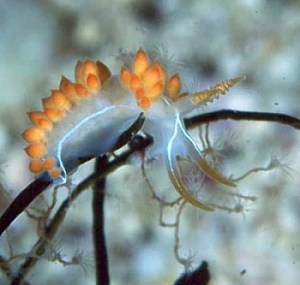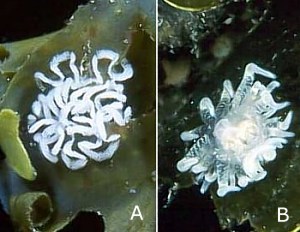Observations on Flabellina trilineata
June 23, 2000
From: Bruce Wight


Great to hear back from you Doc. I hope we can serve as valuable resources to each other in the future. I will look through my files to see if we have any photos of Ancula feeding.
Here is an interesting one for you. Last year my wife and I were photographing juvenile Flabellina trilineata nudibranchs feeding on
hydroids at Isthmus Reef at Catalina Island. They were all over and some did not have the distinctive white striping. The real interesting part came when we got our images back from the lab. In addition to the small nudibranchs we photographed, my wife Johanna and I were also photographing small white clumps on the on the algae. When we looked at the photos through a loupe we noticed her photos were of a F. trilineata eggs mass and my photos were of a small white anemone. They were both very numerous, 1/4" or so in diameter and on the same clumps of algae, in the same area on the reef. Is the anemone trying to mimic the eggs, which may be foul tasting, or are the eggs mimicking the small anemone armed with its nematocysts?
Talked to both Dave Behrens and Mike Miller about it, neither had ever heard of such a thing. What do you think?
Bruce Wight
bwproductions@earthlink.net
Wight, B., 2000 (Jun 23) Observations on Flabellina trilineata. [Message in] Sea Slug Forum. Australian Museum, Sydney. Available from http://www.seaslugforum.net/find/2609Dear Bruce,
Thanks for the photos and your observations. I have put some of your photos at the top of the page. Can you give us some idea of the size of your animals? I am not familiar with this species but I think your photos of animals without the white lines will be of great interest to local experts.
To your question about possible egg-anemone mimicry. Proving that two spectacularly similar organisms are mimics is very difficult. We have quite a few examples of potential mimicry in the Forum, but our chances of actually proving that some of these species have evolved to look alike in shape and colour are very slim. What I can say is that the egg mass shape is a common shape for many aeolids, and similar little whitish anemones are found on brown algae in many parts of the world so its unlikely that the similarity beween the two is a case of mimicry. Mimicry in nature has a special meaning. It doesn't just mean that two or more species look alike. It means they look alike because through evolution one has gradually become more alike the other, or both have become more alike each other. Have a look at my answer to Christine's message for a fuller explanation on mimicry.
Thanks again for sharing your finds with us all,
Best wishes,
Bill Rudman.
Related messages
-
Growth on Flabellina trilineata from California
From: John Yasaki, May 8, 2009 -
Re: Flabellina trilineata from California
From: Clinton Bauder, August 5, 2006 -
Flabellina trilineata from California
From: Aidan Hampson, July 6, 2006 -
Flabellina trilineata feeding
From: James Lyle, August 1, 2005 -
Flabellina trilineata? from California
From: Denise Weisman, June 3, 2005 -
Flabellina trilineata juveniles
From: Sean Kearney, March 23, 2004 -
Flabellina trilineata laying eggs
From: Bruce Wight , August 4, 2003 -
Flabellina trilineata from British Columbia
From: Clinton Bauder, January 21, 2003 -
Flabellina trilineata from San Miguel, Calif.
From: Bruce Wight, August 12, 2002 -
Flabellina trilineata from Canada
From: Marli Wakeling, December 19, 2000 -
Re: Flabellina trilineata rhinophores
From: Bruce Wight, June 30, 2000 -
Re: Flabellina trilineata
From: Bruce Wight, June 27, 2000 -
More observations on Flabellina trilineata
From: Jeff Goddard, June 26, 2000 -
Flabellina trilineata and its amphipod crustacean mimic
From: Jeff Goddard, June 23, 2000
